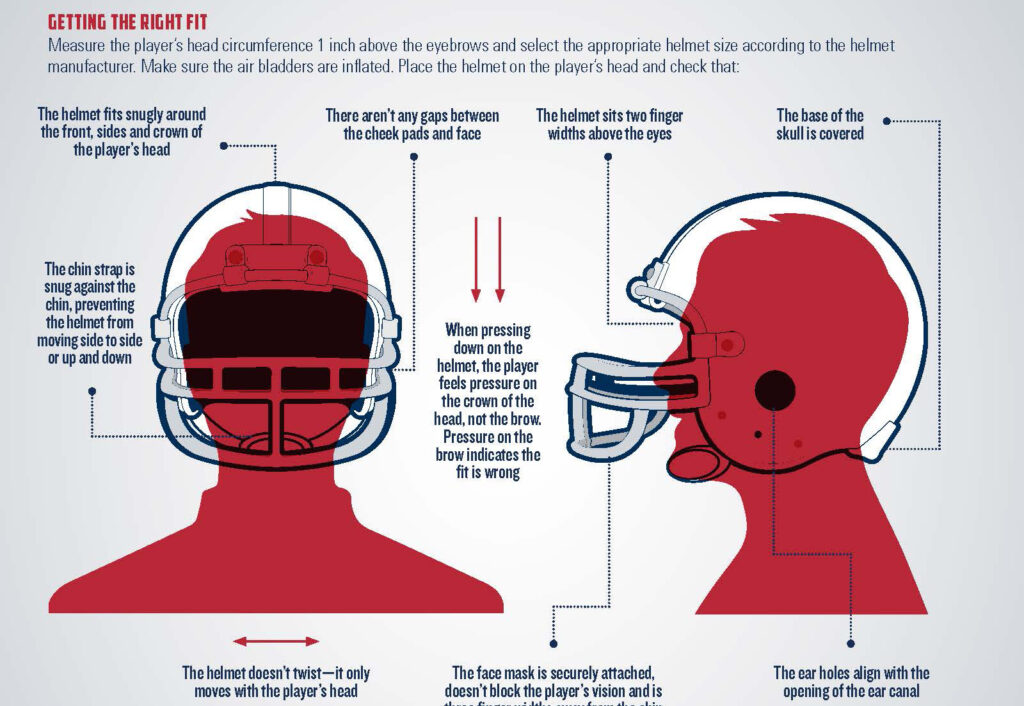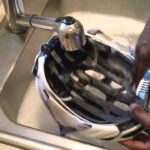A football helmet should fit snugly without causing discomfort. It must stay secure during play without shifting.
Proper helmet fit is crucial for football players. A well-fitted helmet protects against head injuries. It should sit level on the head, covering the forehead. The padding inside must touch the head without any gaps. Straps should be tight but comfortable, ensuring stability.
Players should regularly check the fit, as helmets can loosen over time. A secure fit enhances performance and safety, reducing the risk of concussions. Investing time in achieving the right fit can make a significant difference. Ensure the helmet meets safety standards for optimal protection.
Key Components
Ensuring a football helmet fits correctly is crucial for player safety. Understanding the key components of a football helmet helps achieve the best fit. Below are the main components you need to focus on:
Shell
The shell of a football helmet is its outer layer. This part absorbs and disperses impact forces. A good shell should be durable and lightweight. It should cover the entire head, including the sides and back. Ensure no gaps exist between the shell and your head.
Padding
The padding inside the helmet ensures comfort and safety. It should fit snugly against the head. Padding comes in different thickness levels. The right thickness varies for each player. The padding should not move when you shake your head. Check for wear and tear regularly.
Chin Strap
The chin strap keeps the helmet secure during play. It should be adjustable and tight enough to hold the helmet in place. The strap should not press too hard against the skin. Ensure the chin strap snaps properly and stays locked.
| Component | Function | Key Points |
|---|---|---|
| Shell | Protects from impacts | Durable, lightweight, full coverage |
| Padding | Provides comfort and fit | Snug fit, check thickness, no movement |
| Chin Strap | Secures the helmet | Adjustable, not too tight, snaps properly |
Remember these key points to ensure your football helmet fits properly. A well-fitting helmet can prevent injuries and enhance your performance on the field.
Credit: support.schuttsports.com
Measuring Head Size
Getting the right fit for a football helmet is crucial. A proper fit ensures safety and comfort on the field. The first step is measuring your head size. This process is simple and only requires a few tools.
Tools Needed
- Flexible measuring tape
- Mirror
- Pen and paper
Step-by-step Process
- Wrap the Tape: Place the measuring tape around your head. It should sit about 1 inch above your eyebrows.
- Check the Position: Ensure the tape is level. Use a mirror to check.
- Take the Measurement: Note the circumference in inches or centimeters.
- Record the Size: Write down the measurement. This helps you remember it.
- Compare with Helmet Size Chart: Use the measurement to find the right helmet size. Most brands provide a size chart.
Here is a sample size chart for reference:
| Head Circumference | Helmet Size |
|---|---|
| 20-21.5 inches | Small |
| 21.5-23 inches | Medium |
| 23-24.5 inches | Large |
| 24.5-26 inches | X-Large |
Measuring your head size correctly ensures a good fit. This helps prevent injuries and improves your game performance.
Fitting The Helmet
Getting the right fit for a football helmet is crucial. It ensures safety and comfort during the game. Follow these steps to fit your helmet correctly.
Initial Adjustment
Start by adjusting the helmet’s padding. Make sure the pads are snug but not too tight. The helmet should sit level on your head. The front edge should be one inch above your eyebrows. This provides proper visibility and protection.
Next, check the helmet’s balance. It should not tilt forward or backward. The helmet should feel comfortable and secure. If it moves too much, adjust the padding again.
Securing The Chin Strap
Now, it’s time to secure the chin strap. Buckle the strap and pull it tight. The strap should fit snugly under your chin. You should feel resistance when you open your mouth. This ensures the helmet stays in place during play.
Make sure the chin strap is centered. It should not slide to one side. If needed, adjust the side straps. They should form a “Y” shape, meeting just below your ears.
| Adjustment Step | Description |
|---|---|
| Padding | Adjust to snug fit, helmet level on head |
| Balance | Ensure helmet doesn’t tilt forward or backward |
| Chin Strap | Buckle tight, centered, forms “Y” below ears |
Remember, a well-fitted helmet is essential. It protects your head and enhances your game performance. Follow these steps every time you play.
Comfort And Fit Check
Ensuring a football helmet fits properly is crucial for safety. A well-fitted helmet provides comfort and protection. Let’s explore the comfort and fit check for a football helmet.
Signs Of Proper Fit
A properly fitted helmet is snug and secure. Here are some signs:
- Snug Fit: The helmet should feel tight but not painful.
- Even Pressure: The pressure should be evenly distributed.
- Chin Strap: The strap should be tight and centered.
- Forehead Space: The helmet should sit 1 inch above the eyebrows.
- Movement: The helmet should not move when you shake your head.
Common Fit Issues
Improper fit can cause discomfort and reduce safety. Here are common issues:
- Too Loose: The helmet moves around on the head.
- Too Tight: The helmet causes pain or headaches.
- Uneven Pressure: Pressure points cause discomfort.
- Chin Strap Issues: The strap is too loose or too tight.
- Incorrect Position: The helmet sits too high or too low.
Comfort And Fit Check Table
| Check | Proper Fit |
|---|---|
| Snug Fit | Helmet feels tight but comfortable |
| Even Pressure | Pressure is evenly distributed |
| Chin Strap | Strap is tight and centered |
| Forehead Space | Helmet sits 1 inch above eyebrows |
| Movement | Helmet does not move with head shake |
Adjusting For Different Head Shapes
Finding the right football helmet is crucial. A helmet must fit comfortably and securely. This ensures safety and performance. Different head shapes can make finding the right fit tricky. Let’s explore how to adjust for different head shapes.
Custom Padding Options
Custom padding can make a big difference. It allows for a personalized fit. Many helmets come with adjustable pads. These pads can be moved or replaced.
Here are some common padding options:
- Foam pads
- Gel pads
- Air-filled pads
Each type of padding has its benefits. Foam pads are lightweight and durable. Gel pads provide extra comfort. Air-filled pads offer a snug fit. Choose the padding that suits your head shape best.
Alternative Helmet Styles
Sometimes, standard helmets don’t fit well. In these cases, alternative styles might work better. There are several helmet styles to consider.
Let’s look at some popular options:
| Helmet Style | Features |
|---|---|
| Traditional | Classic design, good for oval heads |
| Revolution | More padding, good for round heads |
| SpeedFlex | Flexible shell, adaptable to various shapes |
Each style offers different benefits. Traditional helmets fit oval heads well. Revolution helmets provide extra padding for round heads. SpeedFlex helmets adapt to various head shapes.
Choosing the right style ensures better protection and comfort. Always try different styles before making a decision.

Credit: www.youtube.com
Maintenance Tips
Keeping your football helmet in top condition ensures safety and longevity. Regular maintenance helps protect you on the field. Follow these tips to keep your helmet in prime shape.
Cleaning The Helmet
Clean your helmet regularly to remove dirt and sweat. Use a mild soap and warm water. Avoid harsh chemicals that can damage the helmet.
- Remove the inner padding carefully.
- Soak the padding in soapy water.
- Rinse and air dry the padding.
- Wipe the outer shell with a damp cloth.
Ensure the helmet is dry before storing it. This prevents mold and bacteria growth.
Replacing Worn Parts
Inspect your helmet for wear and tear. Replace any worn parts promptly.
- Check the chin strap for fraying.
- Examine the inner padding for cracks.
- Look at the outer shell for deep scratches.
Always use parts from the same manufacturer. This ensures compatibility and safety.
| Part | Signs of Wear | Replacement Frequency |
|---|---|---|
| Chin Strap | Fraying or stretching | Annually |
| Padding | Cracks or hard spots | Every two seasons |
| Outer Shell | Deep scratches or dents | As needed |
Regular maintenance keeps your helmet safe and comfortable. Always follow the manufacturer’s guidelines for best results.

Credit: m.youtube.com
Frequently Asked Questions
How Should A Football Helmet Fit?
A football helmet should fit snugly without being too tight. It should sit 1 inch above the eyebrows. The helmet should not move when you shake your head.
What Size Football Helmet Do I Need?
Measure your head’s circumference and check the manufacturer’s size chart. Sizes vary between brands, so always check specific sizing guidelines.
How Tight Should A Football Helmet Be?
A football helmet should be tight enough to stay in place but not cause discomfort. It should press evenly around the head.
How To Adjust A Football Helmet?
Use the adjustable straps and padding to ensure a snug fit. Make sure it covers the entire head evenly.
Conclusion
Ensuring a football helmet fits properly is crucial for safety and performance. A well-fitted helmet protects against injuries. Always check for snugness, comfort, and proper alignment. Remember, a good fit can make a significant difference. Prioritize your safety by choosing the right helmet for your needs.

